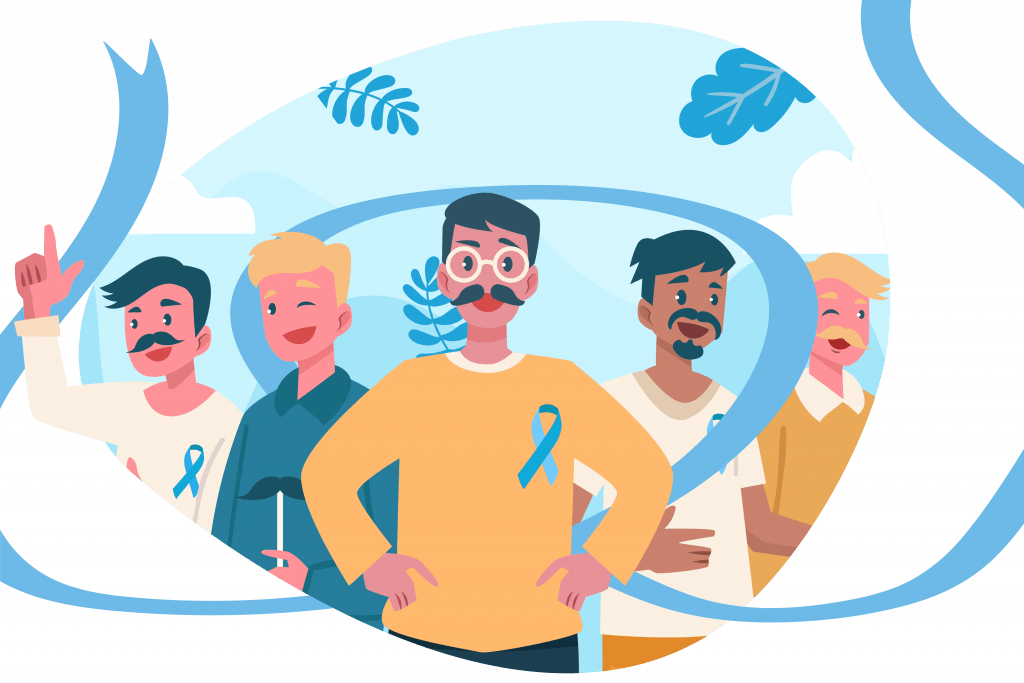Lower Urinary Tract Symptoms (LUTS) in Men: meaning, causes, treatments
As November is Men’s Health Awareness Month, it’s the perfect opportunity to shine a light on Men’s Health, more specifically Men’s Pelvic Health. That is why we’ve collaborated with Phillipa once more to bring you her insights!
Urinary Symptoms in Men
Around 30% of men over 65 will experience issues with the lower urinary tract.
Common symptoms include a weak or intermittent urinary stream, straining, hesitancy, dribbling after urination has finished, needing to go urgently, frequently, and multiple times during the night. Urinary symptoms are not always a sign of Prostate Cancer and can also happen because of an enlarged prostate gland called Benign Prostate Enlargement (BPE). This is a natural part of ageing. Other possible causes of symptoms include abnormalities of the urethra, the bladder, and/or the sphincters (valves that close to prevent loss of urine).
Prostate Cancer Awareness
It is important to know that prostate cancer is the 2nd most common cancer in men worldwide and the 4th most common cancer overall. There were more than 1.4 million new cases of prostate cancer in 2020.
What are the signs of prostate cancer?
Please familiarise yourself with the following symptoms and arrange a check-up with your doctor if you are:
- Needing to pass urine more frequently, often during the night
- Having to rush to the toilet
- Difficulty in starting to pass urine (hesitancy)
- Straining or taking a long time while urinating
- A weak flow
- Feeling that your bladder has not emptied fully
- Blood in urine or semen
If you have received a cancer diagnosis it may be that surgery is offered as part of your treatment. There is a risk of problems or complications after any operation. One potential problem following radical prostatectomy is difficulty controlling your bladder or incontinence. Your surgeon will be able to tell you how likely this is and how long it might take to recover and refer you for treatment if leakage becomes a problem. Some medicines can also help to relieve this symptom. Cancer Research UK

Let’s talk about male incontinence
Incontinence continues to be a taboo subject; it’s a topic of conversation we would happily ignore, and this is especially true for men. A recent conversation with my husband revealed a disturbing lack of knowledge, which I will be working to remedy!
FACT: Men are NOT immune to pelvic health problems.
Factors that contribute to pelvic floor muscle weakness and incontinence include:
- Poor physical fitness
- Prostate surgery
- A long-term cough (Having COVID-19 could be enough to tip you over the edge)
- Constipation and straining to empty your bowels
- Being overweight
Is incontinence an Occupational Hazard?
Some occupations can expose you to risk factors. for example, fast jet aircrew in the military services is exposed to acceleration and multiples of gravity or G-Force regularly. They are taught to do a straining manoeuvre to prevent greying or blacking out, which increases the intra-abdominal pressure and loads the muscles and connective tissue of the pelvic floor.
It is repeated exposure to undue stresses and strains that can compromise the integrity of tissues and lead to pelvic floor dysfunction.
It could be that you are doing lots of heavy lifting at work or even in the gym. Using a poor lifting technique or straining to lift something heavy is going to increase intra-abdominal pressure which can have an adverse effect on the muscles of the Pelvic floor. Perhaps our job is sedentary, which can lead to physical deconditioning and muscle weakness. It’s worth remembering that the pelvic floor is a muscle too!
Don’t let Urinary Symptoms Creep up on You
In my experience problems can slowly creep up on us and we will unconsciously accommodate to symptoms we might be having. Perhaps you are making multiple toilet trips before leaving the house or maybe you are avoiding strenuous exercise and worrying about leaks. In this case, the quality of your life is being impinged, and NOW is the time to act!
The Good News
Lower Urinary Tract Symptoms (LUTS) can be treated, and men’s urinary incontinence can be reduced significantly or may be cured altogether. There are lots of treatment options available.
Your doctor can refer you for specialist assessment by a healthcare professional with specific training in managing urinary incontinence in men, who will teach you muscle exercises to help you control your bladder.
Do you want a 20% discount on your first order?
Receive incontinence tips, expert advice, and promotions by email.
Get to know the Pelvic Floor Muscles: Men have them too!
Pelvic floor muscles can be strengthened like any other weak muscle and need regular exercise to stay strong.
The pelvic floor muscles are a supportive sling of muscles, reaching from the tailbone at the back to the pubic bone at the front. They support the pelvic organs, the bladder and the bowel to help to maintain your continence.
When you pass urine or open your bowels, these muscles should relax and then tighten afterwards to prevent leakage of urine, faeces, and wind.
Pelvic Floor Muscle Training for Men
The first step is ensuring you are working the correct muscles in the right way.
- Sit, stand, or lie comfortably with your thighs, buttocks, and tummy relaxed.
- Imagine you are trying to stop yourself from passing wind at the same time as you are trying to stop passing urine. Slowly squeeze and lift the muscles of your pelvic floor. You may feel the base of your penis move upwards.
- Avoid sucking in your stomach, squeezing your bottom muscles, or holding your breath.
Pelvic floor muscle training is surprisingly difficult, but if you practice it will get easier.
To check that your pelvic floor muscles are working correctly you could stand in front of a mirror when you practice your pelvic floor exercises. You should see the base of your penis and your testicles lift.
If you are in any doubt about whether you are doing these exercises correctly, get professional help.
Sources:
Rees, J. (2010). NICE guideline on lower urinary tract symptoms in men. Trends in Urology &Amp; Men’s Health, 1(2), 34–37. https://doi.org/10.1002/tre.171
Prostate cancer statistics | World Cancer Research Fund International. (2022, April 14). WCRF International. https://www.wcrf.org/cancer-trends/prostate-cancer-statistics/
NHS website. (2021, November 18). Symptoms. nhs.uk. https://www.nhs.uk/conditions/prostate-cancer/symptoms/
Norther Care Alliance. (2022). Men – A Guide to your Pelvic Floor Muscles. NHS.
Pelvic floor muscles in men. (2020, March 2). Continence Foundation of Australia. https://www.continence.org.au/who-it-affects/men/male-pelvic-floor-muscles
Surgery to remove prostate cancer | Cancer Research UK. (n.d.). Retrieved October 27, 2022, from https://www.cancerresearchuk.org/about-cancer/prostate-cancer/treatment/surgery/surgery-remove-your-prostate-gland
